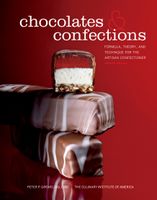Label
All
0
Clear all filters
Save 25% on ckbk Premium Membership with code FALLFLAVORS 🍁
Nuts and Seeds
Appears in
By Peter Greweling and Culinary Institute of America
Published 2007
Nuts and seeds are commonly used in confectionery for their flavor, texture, and fat content. Various nuts may be used by the artisan confectioner; these include hazelnuts, almonds, pecans, and macadamias. While they all differ botanically, their general qualities and handling requirements are virtually the same. Their common trait is a high fat content, and the fat they contain is prone to rancidity. For that reason, nuts and seeds should always be stored in a cool place, away from anything that can contribute to the onset of rancidity: light, oxygen, and reactive metals such as cast iron or copper. The flavor of most nuts is improved from toasting prior to their use. Different nuts reach their peak flavor with different degrees of toasting, and it is up to the confectioner to determine the level of toasting that best complements each variety of nut. The oil content of nuts is a double-edged sword; oil is responsible for much of nuts’ appeal, but it does not store well and can be responsible for fat migration, resulting in softened chocolate and fat bloom. The more finely ground the nuts in a confection are, the more fat is released, and the more pronounced these effects can become. Seeds such as sesame seeds, pumpkin seeds (pepitas), peanuts, and cocoa nibs are all similar to nuts in their storage and use requirements.
Become a Premium Member to access this page
Unlimited, ad-free access to hundreds of the world’s best cookbooks
Over 160,000 recipes with thousands more added every month
Recommended by leading chefs and food writers
Powerful search filters to match your tastes
Create collections and add reviews or private notes to any recipe
Swipe to browse each cookbook from cover-to-cover
Manage your subscription via the My Membership page
Best value
Part of
Advertisement
Advertisement
The licensor does not allow printing of this title


